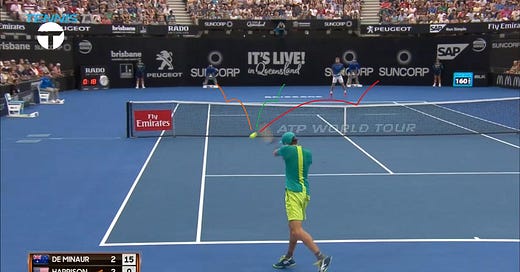What is situation training?
Situation Training is a practice structure that stratifies and simulates the situations players will face during a tennis match, providing the game-specific context necessary for transferrable learning.
Situation Training identifies commonly occurring incoming/outgoing shot patterns in tennis, and blocks them into specific, repeatable, and measureable practice units.
Why is situation training necessary?
Tennis is an extremely open sport, with countless possible shot combinations per point. Therefore, it is necessary to isolate and practice the commonly repeating patterns, so that players are able to identify and address weaknesses, and develop performance relevant technique and tactics.
How does situation training differ from traditional coaching styles?
The continuum of coaching styles ranges from Closed to Open.
The closed end of the spectrum could also be considered the "Stroke Model Methodology" (Elderton). The focus here is on replicating a coach's technical ideal, oftentimes devoid of context. These practices usually consist of the coach feeding balls to lines of waiting players, who hit one or two shots and move to the back.
Not only is this boring, but the players practicing in this method are not learning the game in the context in which it is played. They are not recovering after their shot, they are not learning to read the ball or phase of play, they are not making any decisions whatsoever. Therefore, when these players are exposed to an open competition situation, their carefully crafted, spoon-fed technique falls apart.
On the other end of the spectrum are coaches whose practices are extremely open, consisting solely of players playing sets, or games such as team singles. The issue here is that simply playing points is too random of a practice structure for players to address weaknesses or build strengths--it does not provide the reps nor specific feedback required for improvement.
Situation training bridges the gap between open play and closed drilling. The focus is on situations, not strokes; technique is a byproduct of the demands of the game. This type of practice can be blocked enough to provide the repetitions necessary to build skills, while still random enough in its variations of incoming/outgoing balls that the player learns to receive and adapt in a competition specific environment.
How to practice using Situation Training:
1. Identify the situation to be practiced.
The coach or player identifies the situation to be practiced. This can be one that the player struggled with in open play (match, tournament), or a prescribed situation from the coach's player development plan.
Example: Deep Ball (Defense)
2. Situation Game
The coach applies a game framework to the situation. Players are given a tactical goal, which the rules of the game may incentivize.
Example: Coach feeds a deep ball and the point is played out. If players return the feed deep and to the middle, they win the point automatically.
3. Technical Feedback
The coach closes the situation to provide technical feedback and instruction.
Example: The coach instructs the player in how to perform the “High Spin” contact move to assist in dealing with deep balls.
4. Blocked Technical Practice
The coach allows the player to practice the technique in a closed situation.
Example: The coach feeds 3 sets of 4 deep balls to the player. The player receives 1 point if the ball is in the court, 3 if it lands in the target zone, and -1 if it goes in the net. The player's score is recorded, and compared against past and future scores.
5. Replay Game
The game is replayed using the new technique.
6. Open Play
Players play live points as they would in a match. The players call out when they recognize the situation being practiced, and evaluate their performance between points. The coach looks to see if the player has implemented the new technique.
For more information on effective practice structure, please consider reading:
Effective Practice Structure
In a previous article, I outlined what I believe to be the qualities of effective practice activities. This piece will focus instead on a more macro level; how to incorporate these activities in an effective practice. Session planning begins with three questions:
Is situation training effective?
We will examine Situation Training within the framework for evaluating Deliberate Practice (Ericsson), laid out by Dr. Olav Krigolson.
Deliberate Practice is:
Highly Structured
Situation training is highly structured. Situations are categorized based on specific incoming and outgoing shots, and prioritized based on their frequency and importance in competition. Each situation has an intended strategic and technical outcome, and criteria to evaluate both.
Specific & Relevant
Situation training focuses on the specific patterns and situations inherent in competitive play. Practices are a snapshot of the overall game, focusing on the tactics and technique necessary to play the game.
Targeted & Monitored
This type of training allows coaches and players to isolate and practice specific problem patterns and situations. Success and fail states are made very obvious--in closed situation training, players receive a score at the end of each "set", based on whether their shots ("reps") were on target. Progress is tracked through the Pride Tracks system, allowing players to identify weaknesses, and evaluate their growth.
Mentally & Physically Focused
Situation training is engaging and fun; participants are playing the game that they love. Targets and scoring are scaled based on player ability to provide desirable difficulty. Players compete against themselves and their peers for high-scores and game wins.
Conclusion
Out of all the coaching methodologies, Situation Training is the most in line with the principles of deliberate practice.




